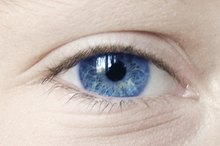What does fact checked mean?
At Healthfully, we strive to deliver objective content that is accurate and up-to-date. Our team periodically reviews articles in order to ensure content quality. The sources cited below consist of evidence from peer-reviewed journals, prominent medical organizations, academic associations, and government data.
The information contained on this site is for informational purposes only, and should not be used as a substitute for the advice of a professional health care provider. Please check with the appropriate physician regarding health questions and concerns. Although we strive to deliver accurate and up-to-date information, no guarantee to that effect is made.
What Causes Eye Floaters in Vision?
Eye floaters are diagnosed when gray or black spots, strings, floating objects or cobweb like shapes appear when the eyes are moved. This visual disturbance occurs when fibers within the eye abnormally clump together and cast shadows on the retina. Occasionally seeing eye floaters may not be a cause for concern 1. However if they appear frequently or are large in number a physician should be consulted, as the eye floaters may be caused by a serious condition.
If you are experiencing serious medical symptoms, seek emergency treatment immediately.
Age Related Changes
With age the eyes naturally go through some changes. This includes the vitreous humor, which is a jelly like substance inside the eyeballs that makes them round. Over time the vitreous humor can begin to become more liquid and shrink in size, states the Mayo Clinic. It may pull away from the eyeball and can begin to clump. These clumps may cast a shadow on the retina and cause floaters to appear. In most cases this change occurs gradually and does not require treatment.
- With age the eyes naturally go through some changes.
- It may pull away from the eyeball and can begin to clump.
Injury and Infections
What Are the Causes of Floaters After Laser Eye Treatment?
Learn More
The National Eye Institute says that any injury to the eye or an infection in the eye may cause floaters 2. Inflammation or uveitis of the eye is another condition that can create this symptom. Underlying autoimmune or inflammatory diseases, infections in other areas of the body that spread to the eye and trauma to the eye can all lead to problems. In severe cases where floaters significantly affect vision, a surgical procedure called a vitrectomy can be done to remove the vitreous gel and any floating debris to help restore vision.
- The National Eye Institute says that any injury to the eye or an infection in the eye may cause floaters 2.
- Inflammation or uveitis of the eye is another condition that can create this symptom.
Bleeding
If the blood vessels in the eye grow abnormally, they may begin to bleed and leak blood into the eye. This can happen with high blood pressure and diabetes both of which can damage blood vessels if they are not well controlled. According to the University of Illinois Medical Center, bleeding in the eye can also cause scars to forml 3. This can cause the retina to shrink, become damaged or even tear.
- If the blood vessels in the eye grow abnormally, they may begin to bleed and leak blood into the eye.
Retinal Detachment
Types of Growths on the Eye
Learn More
The retina can become detached from the back of the eye and cause floaters 4. The retina is responsible for taking the light that enters the eye and creating nerve impulses that can be sent to the brain to be interpreted. The University of Michigan Kellogg Eye Center warns that there is a greater risk of retinal detachment if other conditions such as nearsightedness or glaucoma exist, after cataract surgery, or if there is a family history of retinal detachment 34.
Related Articles
References
- MayoClinic.com: Eye Floaters Causes
- National Eye Institute: Facts About Floaters
- University of Illinois Medical Center: Floaters
- University of Michigan Kellogg Eye Center: Detached Retina
- NIH National Eye Institute. At a glance: Floaters. Updated July 5, 2019.
- American Academy of Opthalmology. What are floaters and flashes? Updated August 23, 2019.
- Harvard Health Publishing. What you can do about floaters and flashes in the eye. Updated June 10, 2013.
- Bergstrom R, Czyz CN. Vitreous floaters. In: StatPearls [Internet]. Updated February 21, 2020.
- Primary Care of the Posterior Segment, Third Edition, Alexander, Larry, McGraw-Hill Publishing, 2002.
Writer Bio
I hold a Master's degree in exercise physiology/health promotion. I am a certified fitness specialist through the American College of Spots Medicine and an IYT certified yoga teacher. I have over 25 years experience teaching classes to both general public and those with chronic illness. The above allows me to write directly to the reader based on personal experiences.







